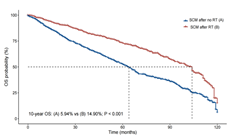Risk and prognosis of second cutaneous melanoma after radiotherapy for breast cancer: A population-based analysis
DOI:
https://doi.org/10.17305/bb.2023.10029Keywords:
Breast cancer (BC), second primary malignancies, cutaneous melanoma, radiation therapy (RT), survival outcomes, The Surveillance, Epidemiology, and End Results (SEER)Abstract
Radiation therapy (RT), a primary treatment for breast cancer (BC), may be associated with increased non-BC tumor risk. We aimed to examine second cutaneous melanoma (SCM) risk in BC patients who underwent RT and to assess their survival outcomes. Data from 520,977 BC patients diagnosed between 1973–2018 were collected from the Surveillance, Epidemiology, and End Results (SEER) database. Cumulative SCM incidence was estimated using the Fine–Gray competing risk model. Poisson regression analysis was conducted to calculate the standardized incidence ratio (SIR) and estimate the SCM relative risk in patients who underwent RT compared to those who did not. Overall survival (OS) and cancer-specific survival (CSS) were assessed using the Kaplan‒Meier method. Among the 520,977 BC patients, 243,676 (46.8%) underwent surgery and RT, while 277,301 (53.2%) only underwent surgery. Our results suggest that BC patients receiving RT had a higher SCM risk than those who did not (hazard ratio [HR] 1.40; 95% confidence interval [CI] 1.30-1.51; P < 0.001). SCM incidence was also higher in BC patients treated with RT than in the general US population (SIR 1.12; 95% CI 1.05-1.19; P < 0.05). However, SCM patients who received RT had a significantly higher 10-year survival rate than those who did not receive RT (14.90% vs 5.94%; P < 0.001). No significant difference was found in 10-year OS or 5-year CSS between SCM following RT and only primary cutaneous melanoma (OPCM), but SCM patients who did not receive RT had a significantly lower 10-year OS, with no significant difference in CSS. This study suggests an increased SCM likelihood in BC patients due to RT, although the overall risk is minimal.
Citations
Downloads

Downloads
Additional Files
Published
License
Copyright (c) 2024 Tianxin Luo, Yani Zhang, Tianliang Chen, Yanxia Cai, Zheng Yang

This work is licensed under a Creative Commons Attribution 4.0 International License.
How to Cite
Accepted 2024-01-01
Published 2024-01-10









